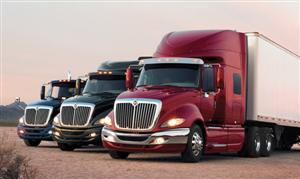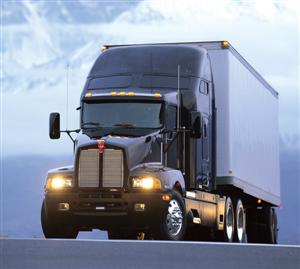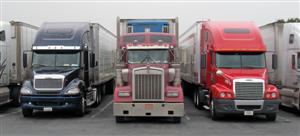JANUARY 2008 TRUCKER TALK
SQUARE IS OUT – ROUND IS IN
BY OWNER OPERATORS ROD & KIM GRIMM
Back in the day, the big square-hooded conventionals were the trucks most drivers dreamed of, and the cabovers, which were virtually nothing more than rolling boxes, were all the rage. But, over the years, everything changed completely when efficiency became the most important feature on a truck. It doesn’t seem like so long ago, back in 1985, when Kenworth rolled out the first T600 and reaction was mixed. The strange new look was going to take some getting used to. But who knew how important this design would become. Today, virtually every brand of truck has at least one model that is similar in design to the old T600.
I remember the first time I saw a T600 – I thought it was the ugliest thing anyone had ever done to a truck. Because of its sloped hood, the T600 quickly became known as the “Anteater” for its resemblance to the funny animal with the long, pointy nose. In 1989 we moved out of a double bunk cabover Kenworth and into our first T600. And, to our surprise, it was absolute heaven! Trading in a 310 Cat for a 425 was nice in the power department, but being able to walk into the bunk instead of crawling over the doghouse was wonderful!
The selling points of the T600 were maneuverability and increased fuel mileage. And I must say, they do handle well (at least the three that we drove over the years all did). In fact, the T600’s handled a lot better than our current Kenworth W900 in the snow and ice. When we got out of our last T600 and into our W900, we had to learn to allow more room for turns and make adjustments when backing up. The backing up was helped when we got our 48’ spread-axle trailer and gained the ability to dump the air in the back axle. I don’t know exactly why it works, but it does.
 After their introduction, many companies started buying these new trucks, and as more and more hit the road, and other companies started adding them to their fleets, the truck became more acceptable to truckers. I suppose it just took some time to get used to the new look. Other truck manufacturers took note, too, and started offering their own aerodynamic models. And so trucking has gone – more curves, steeper sloped hoods, and designs that hide anything that could cause drag.
After their introduction, many companies started buying these new trucks, and as more and more hit the road, and other companies started adding them to their fleets, the truck became more acceptable to truckers. I suppose it just took some time to get used to the new look. Other truck manufacturers took note, too, and started offering their own aerodynamic models. And so trucking has gone – more curves, steeper sloped hoods, and designs that hide anything that could cause drag.
But many of these aerodynamically-designed trucks have caused mechanics to have nightmares! Just like cars, that used to be easy to work on but now aren’t, trucks have followed suit. Look under the hood of today’s 4-wheelers and you might just wonder where the engine is hiding amidst all that plastic. Well, that’s where trucks are headed, for sure. I suppose it’s easy to get to everything when they are putting a truck together in the factory, but it’s not always so easy anymore to fix your truck on the side of the road when it breaks down.
With fuel prices through the roof, the aerodynamic designs have gained in popularity, and the new look is only getting more aerodynamic. The old classics will soon go the way of the dinosaurs and be gone forever. Peterbilt’s 379 is already gone – the last one rolled off the assembly line on April 4, 2007. The model that is replacing this legend is the 389, which is a more aerodynamic version of the old, square 379. Kenworth’s W900 is hanging in there for now, but I’m sure the day will soon come when the last one of them will roll off the production line, too. When that day comes, it will be the end of an era.
Did you know that Lexus is designing many of the dashes in today’s trucks? As time goes on, I think we will see more and more car-like features in the new trucks. A steering wheel with everything at your fingertips is great if it works, but I wonder what they will cost to replace when something goes wrong after the warranty expires. Most of the new trucks now have “pry point” dash panels instead of bolts. These types of dash panels are great in a car, but how practical are they in a truck. Interiors, in regards to comfort and function, are getting much better, though. Many of the modern conveniences you can get in an OEM bunk today used to only be available in a big, custom, aftermarket sleeper. Today’s interiors offer more storage and better use of space – and that is a good thing.
We were very impressed with International in Louisville last year – they were measuring real drivers to help design their new seats. And let’s face it, where does a driver spend most of their time? If you can get to the truck show in Louisville this year, International will be unveiling another new truck (they unveiled the ProStar in 2006). We were at some of the International meetings when they asked drivers for input on developing this new truck, but neither we nor any of the other drivers that were at those meetings have seen the final product. But the pictures they teased us with were awesome! I can’t believe that I am even saying that about an International – I am a KW girl, through and through. But if they come out with something that looks close to what they teased us with, Kenworth and Pete better watch out!
 Looking at the modern trucks of today, I don’t think there are so many new drivers out there dreaming of owning that big Kenworth or Pete hood. If they are, dreaming is as far as it will go. To run a cost-effective operation and survive today, drivers have to consider the weight and fuel mileage of their truck, just to make ends meet. Long gone are the days of buying what you want – today, you buy what you need.
Looking at the modern trucks of today, I don’t think there are so many new drivers out there dreaming of owning that big Kenworth or Pete hood. If they are, dreaming is as far as it will go. To run a cost-effective operation and survive today, drivers have to consider the weight and fuel mileage of their truck, just to make ends meet. Long gone are the days of buying what you want – today, you buy what you need.
Wind tunnel testing is helping designers cut down on drag, and that is good. But with less drag, you have to realize that it will also take more time to stop. The truck isn’t helping with that so much anymore. Air assisted disc brakes are already being offered on some trucks, but nothing weighing 80,000 lbs. and going 55 mph (or faster) can stop on a dime – no matter what kind of brakes it is equipped with. And that could become a problem as they continue to make trucks faster and more powerful.
Along with making the new trucks more aerodynamic, manufacturers are also making them lighter. To do that, they are using more plastic in places that used to be metal. In today’s disposable society it means that trucks, like everything else, aren’t being built to last 20+ years anymore. We’ve talked to friends that have newer trucks and many of them are not so happy with some of these changes. We used to have a freezer that my grandma once owned that worked fine for over 40 years. I don’t think anyone who buys an appliance today expects it to last more than 10 years. And that goes for most everything we buy today, including trucks.
I just recently heard on the news that CARB (California Air Resources Board) passed a law that will eventually ban trucks that are 1993 and older from the ports in Los Angeles and Long Beach. In the report, I heard that the average age of trucks coming into California is four years old, and the average age of truck’s inside the state is about twelve years old. Obviously, they (CARB) want these “old” trucks off the road. New emission standards seem to be promoting this “disposable truck” mentality. Why build a truck that will last for two decades or more when it will have to be replaced to update the emissions in just a few years?
Our friends Russ & Debbie Brown just traded off their cool 1999 Freightliner Classic for a brand new Pete 386, citing the fuel savings they are expecting as one of their main reasons for the trade. In fact, they are thinking that what they will save on fuel might be enough to actually make the payment. They drove a T600 before buying their first W900, and now, after owning four classic-shaped trucks, they have decided to go back to the sloped hood style. In the short time they’ve owned the truck, they really like some of the new features, like being able to just push on the dome lights to turn them on or off. Russ says he doesn’t really mind the new rocker-style switches saying, “It cleans up the dash.”
While searching the truckstop parking lots, looking for new trucks sitting next to older ones to photograph for this article, I really began to realize just how many of these aerodynamically-shaped trucks are already out here. My eyes were opened. Like it or not, the new look is here.
We can’t imagine what trucks will look like ten years from now, just like we couldn’t imagine ten years ago how they would look today. As technology keeps touching every part of our lives, it will keep changing the trucks we drive. We might not see it in our lifetime, but someday our grandchildren or great grandchildren might really live in a Jetsons-like world. For those of you too young to remember, The Jetsons was an animated television series that aired back in the 1960’s and featured the misadventures of a futuristic family that traveled in flying cars. Maybe the writer of that cartoon knew more about the future than we could have ever imagined.
And who knows, maybe square hoods will make a comeback someday. Bell bottoms, peace signs and everything else from the 1970’s has come around again, why not trucks? All I know is that our old (1998) KW just turned two million miles, and she still looks and runs great. I don’t think we’ll be replacing her anytime soon with a new “rounded” rig. Stay tuned!
